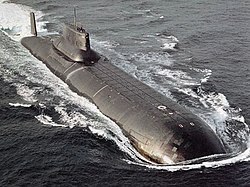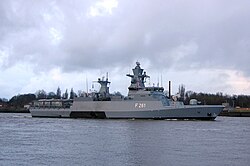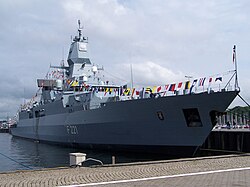Warship
A warship is a ship carrying weapons, which is used by the navy. Some warships also carry naval aircraft, these are called aircraft carriers.

Warships are made in many different sizes. Here is a list of different kinds of warships, from the largest to the smallest of World War II:
| Type | Weight[note 1] | Weapons and notes |
|---|---|---|
| Battleship | 35,000 | 12" to 18" naval artillery guns |
| Aircraft carrier | 27,000 | Fully loaded with aircraft, an aircraft carrier weighed over 36,000 ton. |
| Battle cruiser | 25,000 | 10" to 12" guns |
| Cruiser | 10,000 | Heavy cruiser had 8" guns or larger Light cruiser had less than 8" guns. |
| Destroyer | 2,000 | 4" to 6" guns. |
| Frigate | 1,500 | 3" to 5" guns |
| Submarine | 1,500 | torpedoes |
| ||
Modern warships
It is a principle of modern navies that larger ships never travel alone. They are too vulnerable to planes, submarines and missiles. An aircraft carrier will have an AEW&C plane above to give wider radar warning, destroyers and submarines deployed around. This is recognised by the term "Carrier Strike Group". This is a U.S. term, but the principle applies to all large navies.[1][2][3]
Modern warships come in the same "class" of ship as they did in World War II, but the sizes are different. From largest to smallest:
- Aircraft carriers are airports at sea. They are often called "floating cities" because they can hold hundreds of planes, and thousands of sailors. US Nimitz class carriers can weigh over 100,000 ton.
- Escort carriers are smaller aircraft carriers. They have fewer planes and sailors, but are usually faster.
- Helicopter carriers are used by the US Marine Corps and some navies such as Japan's.
- Battleships are not used anymore. This is because they are expensive to operate and not safe from enemy air attacks. Smaller battleships may be called battle cruisers. Battle cruisers have less armor and guns than a battleship, but are faster.
- Cruisers and frigates are often now the same size. They are mainly used to launch guided missiles or to shoot down enemy airplanes. Cruisers are usually slower and larger and have longer range than frigates. Most cruisers and frigates are large enough to operate helicopters on the back of the ship. This part is called the fantail. Cruisers can usually hold one or two. Although they are smaller, some frigates are designed to hold two or three.
- Destroyers are smaller and faster than cruisers and frigates. They are usually used to hunt down enemy submarines. Sometimes, they will also attack enemy airplanes. They can also go closer to shore than larger ships. This allows them to attack things on land.
- Submarines can hide under the water. Modern large submarines are powered by nuclear reactors and can go round the world underwater. Some provide a "nuclear deterrent".
Other uses
Support warships are used to supply ammunition, food, and other supplies to the larger warships. Some warships exist to carry powerful radio receivers and computers to detect and analyze transmissions from nearby ships. Usually these kinds of ships are smaller, and do not have many guns or missiles themselves.
Warship Media
The Cannon Shot (1670) by Willem van de Velde the Younger, showing a late Dutch 17th-century ship of the line
Russian Typhoon-class submarine
American submarine USS Plunger
A fast attack craft of the Chilean Navy
An Osa I class missile boat in 1983.
INS Sunayna, an Indian Offshore Patrol Vessel
Magdeburg, a German Braunschweig-class corvette (2008)
A German Sachsen-class frigate (2006)
British destroyer HMS Daring visiting Gibraltar in 2016
References
- ↑ Gibson, Chris 2011. The Admiralty and AEW: Royal Navy Airborne Early Warning Projects. Blue Envoy Press. ISBN 978-0956195128
- ↑ Lloyd, Alwyn T. 1987. Boeing 707 & AWACS in detail and scale. Falbrook, CA: Aero Publishers. ISBN 0-8306-8533-2
- ↑ Gordon, Yefim & Komissarov, Dmitriy 2010. Soviet/Russian AWACS Aircraft: Tu-126, A-50, An-71, Ka-31. Red Star Vol. 23. Hinckley, England: Midland Publishing. ISBN 978-1857802153











